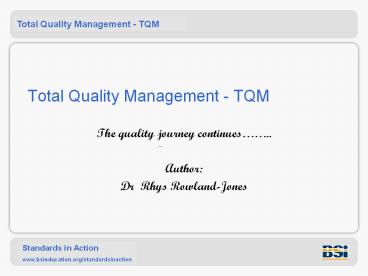Total Quality Management - TQM - PowerPoint PPT Presentation
1 / 25
Title:
Total Quality Management - TQM
Description:
TQM is a philosophy which applies equally to all parts of the organization. ... Program, National Institute of Standards and Technology, Gaithersburg, MD 20899. ... – PowerPoint PPT presentation
Number of Views:249
Avg rating:3.0/5.0
Title: Total Quality Management - TQM
1
Total Quality Management - TQM
- The quality journey continues..
- Author
- Dr Rhys Rowland-Jones
2
Session Plan
- Introduction to concepts of TQM
- Standards and TQM
- TQM Reasons for failure
- Measurement of Quality
3
Total Quality Management
- TQM is a philosophy which applies equally to all
parts of the organization. - TQM can be viewed as an extension of the
traditional approach to quality. - TQM places the customer at the forefront of
quality decision making. - Greater emphasis on the roles and
responsibilities of every member of staff within
an organization to influence quality. - All staff are empowered.
4
Total Quality Management
Doing things right.. .FIRST time.
Internetix (2005)
5
British Standards on TQM
- BS 7850-11992
- Total quality management. Guide to management
principles. - BS 7850-21994,
- ISO 9004-41993
- Total quality management. Guidelines for quality
improvement.
6
Elements of TQM
- Leadership
- Top management vision, planning and support.
- Employee involvement
- All employees assume responsibility for the
quality of their work. - Product/Process Excellence
- Involves the process for continuous improvement.
7
Elements of TQM
- Continuous Improvement
- A concept that recognizes that quality
improvement is a journey with no end and that
there is a need for continually looking for new
approaches for improving quality. - Customer Focus on Fitness for Use
- Design quality
- Specific characteristics of a product that
determine its value in the marketplace. - Conformance quality
- The degree to which a product meets its design
specifications.
8
A fundamental concept of TQM from BS 7850 - a
Process
- A set of inter-related resources and activities
which transform inputs into outputs. (ISO 8402). - Any activity that accepts inputs, adds values to
these inputs for customers, and produces outputs
for these customers. The customers may be either
internal or external to the organization. (BS
7850)
9
"The Simple Process"
(Source BS 7850 1992, Total Quality
Management)
10
Changing Role of the Process Owner
(Source BS 7850 1992, Total Quality
Management)
11
TQM organizational Cultural Change
Traditional Approach Lack of communication Control
of staff Inspection fire fighting Internal
focus on rule Stability seeking Adversarial
relations Allocating blame
TQM Open communications Empowerment Prevention Ext
ernal focus on customer Continuous
improvement Co-operative relations Solving
problems at their roots
12
Perceived quality is governed by the gap between
customers expectations and their perceptions of
the product or service
Customers expectations for the product or service
Customers perceptions of the product or service
Customers perceptions of the product or service
Customers expectations of the product or service
Customers perceptions of the product or service
Customers expectations for the product or service
Expectations gt perceptions
Expectations perceptions
Expectations lt perceptions
Source Slack et al. 2004
13
Additional views of Quality in Services
- Technical Quality versus Functional Quality
- Technical quality the core element of the good
or service. - Functional quality customer perception of how
the good functions or the service is delivered. - Expectations and Perceptions
- Customers prior expectations (generalized and
specific service experiences) and their
perception of service performance affect their
satisfaction with a service. - Satisfaction (Perception of Performance)
(Expectation)
14
A Gap model of Quality
Source Parasuraman, Zeithman and Berry. 1985
15
Continuous Improvement
- Philosophy that seeks to make never-ending
improvements to the process of converting inputs
into outputs. - Kaizen Japanese word for continuous
improvement.
16
Implementing TQM
- Successful Implementation of TQM
- Requires total integration of TQM into day-to-day
operations. - Causes of TQM Implementation Failures
- Lack of focus on strategic planning and core
competencies. - Obsolete, outdated organizational cultures.
17
Obstacles to Implementing TQM
- Lack of a company-wide definition of quality.
- Lack of a formalized strategic plan for change.
- Lack of a customer focus.
- Poor inter-organizational communication.
- Lack of real employee empowerment.
- Lack of employee trust in senior management.
- View of the quality program as a quick fix.
- Drive for short-term financial results.
- Politics and turf issues.
18
Some criticisms of TQM
- Blind pursuit of TQM programs
- Programs may not be linked to strategies
- Quality-related decisions may not be tied to
market performance - Failure to carefully plan a program
19
PDCA Cycle repeated to create continuous
improvement
Performance
Plan
Do
Act
Check
Continuous improvement
Time
20
Recognizing and rewarding Quality
- Promotion of high quality goods and services
- Malcolm Baldrige National Quality Award (MBNQA)
(United States) - Deming Prize (Japan)
- European Quality Award (European Union)
- ISO9000 certification
21
The integrated framework of the Baldrige Award
criteria
Source 2004 Criteria for Performance Excellence,
U.S. Dept. of Commerce, Baldrige National Quality
Program, National Institute of Standards and
Technology, Gaithersburg, MD 20899.
(www.quality.nist.gov)
22
Continual improvement of the quality management
system
Customers (and other interested parties)
Customers (and other interested parties)
Management responsibility
Measurement, analysis and improvement
Resource management
Satisfaction
Requirements
Input
Output
Product realisation
Product
Key Value adding activity information flow
Source BS EN ISO 90012000
23
Overview of the EFQM Excellence Model
24
Quality Award common elements
- All take holistic approach
- Customers/people
- Measurable characteristics
- Visible
- Basis taken from TQM
25
Summary
- TQM a way of working
- Involves everyone
- High prominence on customer
- Awards based upon TQM































